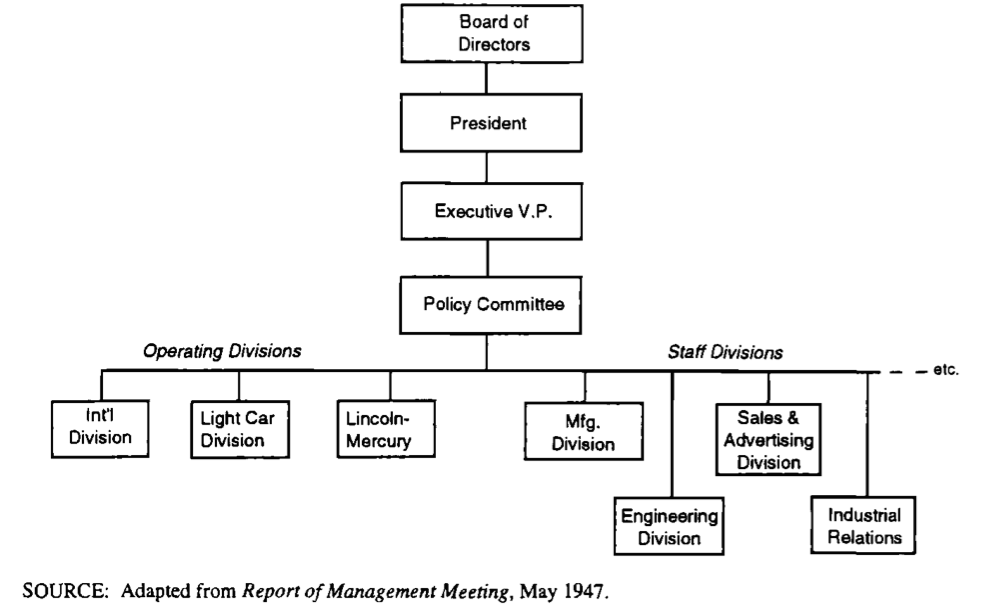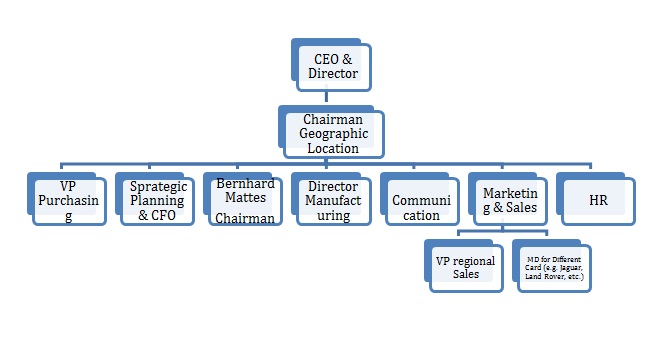Introduction
This report summarises the managerial and organisational structures of Ford Motor Company. An analysis of the market environment in which Ford occupies will be taken into consideration to determine the internal and external factors that affect their organisation.
Historical Background
Henry Ford started Ford Motors in Detroit, Michigan in 1903. He started the company with initial capital of $28000 capital and over time, it grew to be the biggest car manufacturer in the world (Bak 2003). The company made various models of card in its initial years of production. Production increased considerably in the post world war II era. The company went public in 1956 after the death of tis founder, Henry Ford (Ford 2014). Today, Ford is one of the largest automobile manufacturers of the world. It has posted revenue of $134,252 million in 2012. Though in 2011, this was a decline over its previous year’s revenue.
Management Evolution
The evolution of the management structure and that of the organization has been varied in Ford Motors. Initially, Ford was an ideal example of the Old Tail structure of organizational management wherein there was the CEO at the top of the command chain with executive vice presidents in charge of different divisions in the company (Hounshell 1995). The company had a decentralised divisional structure in 1946 (see figure 1, Appendix) (Hounshell 1995).
Eventually the organization structure took the shape of a dual matrix structure where the management structure was based on function as well as operational division. With globalisation, the structure further changed, incorporating the regional elements of the organization within the structural diagram (Hoffman 2012). As a result, this created a global matrix organizational structure within the company to deal with its expansion into the global marketplace.
Organisational structure and its fit with the external environment
What is the organisational structure of Ford?
The contingency approach that Ford has adopted seems to be more task orientated leadership than relationship orientated. This is supported by the Ford’s CEO, Alan Mullaly: “It’s about figuring out a way to get every employee to understand the vision of the company, buy in to the plan, and feel supported in their jobs.” (Nisen 2013, para 1)
Ford has a hybrid structure consists of geographical locations, functional operations and product divisions. This structure can create confusion, which affects their performance due to the complexity of their hierarchy levels (see figure 2) (Ford 2014).
The external environment affecting Ford
To have a better understanding of the automobile industry, it is important to analyse the external factors by using the TASK environment model. This model consists of four “sectors that have a direct working relationship with the organisation, among them customers, competitors, suppliers and the labour market” (Kendrick, M. & Vershinina 2010, p. 91).
Customers
A company such as Ford cannot just simply develop and market its products without taking into consideration how best to allocate specific resources in determining where a car needs to go, which areas should the company allocate services, how will product purchases be processed and how its customer service division should deal with inquiries and client requests (Muller 2014).
Customer loyalty is crucial and organisations must have the ability to understand and satisfy the needs of the target audience to gain their trust. Ford stated that they monitor their customers’ comments about their products online such as social media, enabling them to be aware of their consumers’ needs and satisfaction (Halliday 2012). This real time knowledge about the customers is passed on to the respective departments in form of a report to facilitate their operation (Ford 2012).
Competitors
Ford’s technological aspect of innovation and creativity gives them the competitive edge to compete with the successful competitors. It is essential that the organisation identify the needs of the consumers so that they can implement the trends into their product or service to sustain the competitive advantage.
How Ford is affected by its competitors?
An organizational structure acts as a cushion to the shocks and volatility of the external environment and helps the employees to concentrate on their assigned tasks, resulting in higher levels of internal efficiency. The use of modern knowledge base and information system allows the company to counter the volatility of the external environment (Hoffman 2012).
Such a process can be enforced with the aid of a vertically oriented centralised management system (Bonini & Kaas 2010). This process enables the company to change based on market demand while at the same time facilitates better internal operations through the departmentalisation of specific tasks.
Management structure and its fit with the internal environment
What is the management structure of Ford?
The management structure of Ford is a complex, dual matrix system. The systems are decentralized, based on divisions and geographic location, but they have a centralized management at the same time. This duality in the structure makes in more complex. Ford has a masculine management structure with all male members in it. Too many layers in hierarchy makes daily operations cumbersome. It can be described as having a high level of centralisation and autocratic structure with high degree of masculinity in its culture (Muller 2014).
The internal environment of Ford
The internal environment of Ford is also based on the organizational structure. The organization has a complex structure and hence, it becomes imperative to acknowledge the complexities in operation of the company (Muller 2014). They have a complete team of executives who are responsible for manufacturing to marketing and sales of the product in regional divisions (Bak 2003). Recently Ford has launched on team one plan program to unify its diversified divisions in order to show greater cohesion (LaRocco 2014).
Conclusion
Organizational structure of an organization has serious implication on its operations. The structure is important to have a streamlined supply chain and customer support in place. Ford’s susceptibility to the external shocks has rendered the company almost bankrupt and hence, its structure requires change. The new initiative launched would probably make the company stronger.
References
Bak, R 2003, Henry and Edsel: the creation of the Ford Empire, John Wiley & Sons, Hoboken, NJ.
Bonini, S & Kaas, H-W 2010, Building a sustainable Ford Motor Company: An interview with Bill Ford, Web.
Ford 2014, Corporate Officers. Web.
Ford 2012, Sustainability, Web.
Ford 2014, Sustainability, Web.
Halliday, J 2012, Ford Taps Social Media for Customer Service.
Hoffman, BG 2012, American Icon: Alan Mulally and the Fight to Save Ford Motor Company, Crown Publishing Group, New York.
Hounshell, D 1995, ‘Ford Automates: Technology and Organization in Theory and Practice’, Business and Economic History 24(1), pp. 59-71.
Kendrick, RL, M. & Vershinina, N 2010, Management: International edition, South-Western Higher Education, Hampshire.
LaRocco, LA 2014, For Mulally, Ford’s Culture Is Job One.
Muller, J 2014, For Ford, This Is Where It Starts To Get Tricky.
NPR 2006, A Timeline of Ford Motor Company.Web.
Nisen, M 2013, Alan Mulally Explains How He Turned Around Ford.
Appendix
Figure 1: Ford Motor Company Time Line (NPR 2006)

